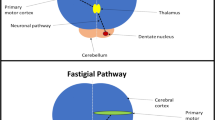Abstract
The purpose of this study was to test our hypothesis that the serotoninergic system plays a significant role in airway obstruction during sleep, by focusing on patterns of serotoninergic innervation of the medullary motoneurons involved in upper airway control. We used the combined techniques of retrograde labelling of motoneurons with unconjugated cholera toxin B and immunohistochemistry with antiserum against serotonin (5-HT). The retrograde tracers were injected into posterior cricoarytenoid (PCA), cricothyroid (CT), and genioglossal (GG) muscles of the cat. Motoneurons retrogradely labelled from PCA were identified ipsilateral to the injection site in the caudal part of nucleus ambiguus (NA). Serotonin immunoreactive terminals surrounded their somata and proximal dendrites, suggesting a strong influence of serotonin on the PCA-labelled motoneurons. Motoneurons retrogradely labelled from CT were located ipsilaterally in two distinct groups in the rostral NA and in the retrofacial nucleus (RFN). Selective peripheral nerve section revealed that the CT-labelled motoneurons in the NA had axons in the recurrent laryngeal nerve, whereas the other CT-labelled motoneurons in the RFN were innervated through the superior laryngeal nerve. In the RFN, the pattern of 5-HT innervation in relation to the CT-labelled motoneurons was analogous to that observed with the PCA-labelled motoneurons. In the NA, however, 5-HT terminals made few contacts with the CT-labelled motoneurons, although a dense network of 5-HT terminals was present in the surrounding region. In the GG-labelled motoneuron region of the hypoglossal nucleus, 5-HT terminals were apposed to distal dendrites, not to the soma, indicating less effect of serotonin on GG than on PCA activity. The present results demonstrated that the patterns of 5-HT innervation vary according to the type of motoneurons and their projections to the upper airway.
Similar content being viewed by others
References
Aldes LD, Marco LA, Chronister RB (1989) Serotonin-containing axon terminals in the hypoglossal nucleus of the rat: an immuno-electronmicroscopic study. Brain Res Bull 23:249–256
Arita H, Ochiishi M (1991) Opposing effects of 5-hydroxytryptamine on two types of medullary inspiratory neurons with distinct firing patterns. J Neurophysiol 66:285–292
Davies PJ, Nail BS (1984) On the location and size of laryngeal motoneurons in the cat and rabbit. J Comp Neurol 230:13–32
Dubner R, Sessle BJ, Storey AT (1978) Swallowing and other related reflexes. In: Dubner R et al. (ed) The neural basis of oral and facial function. Plenum Press, New York, pp 348–376
Fuxe K, Agnati LF (1991) Volume transmission in the brain. (Advances in neuroscience, vol 1) Raven Press, New York
Gacek RR (1975) Localization of laryngeal motor neurons in the kitten. Laryngoscope 85:1841–1860
Hinrichsen CFL, Ryan AT (1981) Localization of laryngeal motoneurons in the rat: morphological evidence for dual innervation? Exp Neurol 74:341–355
Holtman JR Jr (1988) Immunohistochemical localization of serotonin- and substance P-containing fibers around respiratory muscle motoneurons in the nucleus ambiguus of the cat. Neuroscience 26:169–178
Jacobs BL, Gelperin A (1981) Serotonin neurotransmission and behaviour. MIT, Cambridge, MA
Jiang C, Mitchell GS, Lipski J (1991) Prolonged augmentation of respiratory discharge in hypoglossal motoneurons following superior laryngeal nerve stimulation. Brain Res 538:215–225
Kalia M, Mesulam MM (1980) Brain stem projections of sensory and motor components of the vagus complex in the cat: II. Laryngeal, tracheobronchial, pulmonary, cardiac, and gastrointestinal branches. J Comp Neurol 193:467–508
Mathew OP, Sant'Ambrogio FB, Woodson GE, Sant'Ambrogio G (1988) Respiratory activity of the cricothyroid muscle. Ann Otol Rhinol Laryngol 97:680–687
Okado N, Homma S, Ishihara R, Sato H, Kohno K (1988) Differential innervation of specific motor neuron pools by serotoninergic fibers in the chick spinal cord. Neurosci Lett 94:29–32
Rudomin P (1966) The electrical activity of the cricothyroid muscle of the cat. Arch Int Physiol Biochem 74:135–153
Sherrey JH, Megirian D (1980) Respiratory EMG activity of the posterior cricoarytenoid, cricothyroid and diaphragm muscles during sleep. Respir Physiol 39:355–365
Trulson ME, Jacobs BL (1979) Raphe unit activity in freely moving cats: correlation with level of behavioral arousal. Brain Res 163:135–150
Yoshida Y, Miyazaki T, Hirano M, Shin T, Kanaseki T (1982) Arrangement of motoneurons innervating the intrinsic laryngeal muscles of cats as demonstrated by horseradish peroxidase. Acta Otolaryngol 94:329–334
Wetzel DM, Kelley DB, Campbell BA (1980) Central control of ultrasonic vocalizations in neonatal rats: I. Brain stem motor nuclei. J Comp Physiol Psych 94:596–605
Author information
Authors and Affiliations
Rights and permissions
About this article
Cite this article
Arita, H., Sakamoto, M., Hirokawa, Y. et al. Serotonin innervation patterns differ among the various medullary motoneuronal groups involved in upper airway control. Exp Brain Res 95, 100–110 (1993). https://doi.org/10.1007/BF00229659
Received:
Accepted:
Issue Date:
DOI: https://doi.org/10.1007/BF00229659




